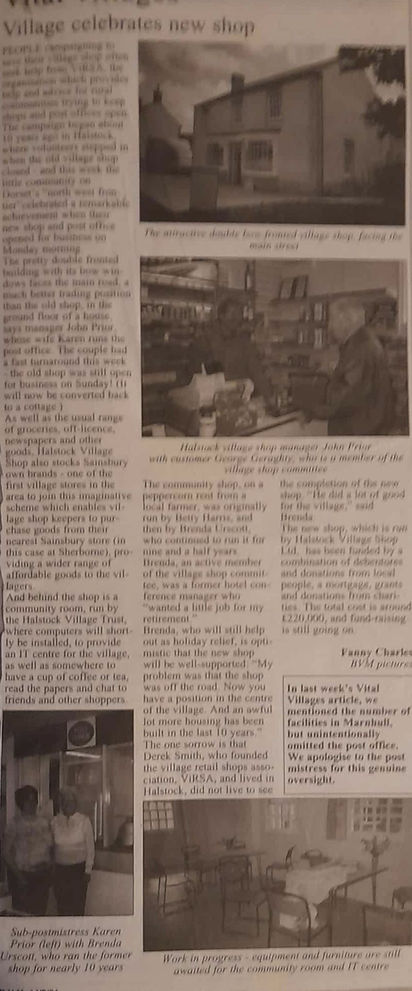Halstock Past
Scroll down for:
-
The way we were
-
School Days and Church
-
How we have grown - maps 1903 & 2005
Audrey Clarke's Archive
-
The Legend of Halganstoc 1995
-
Halstock at Home 1 August 1987
-
History of the Shop & Post Office
-
The Birth of Bransford (as we know it)
The way we were


.jpg)
In more recent times, change has been brought about by factors such as the impact of global economics on farming and the effect of house prices on the ability of local folk to afford property in this area.
These changes were difficult for some members of the community, who cherished the close-knit interdependence of the old days in which no-one minded when farmers drove their cows through the village to fresh pasture or the milking parlour. But the sense of community survived and the village has a whole new make-up.
Understanding all these things helped to cope with change and enabled newer and younger villagers to understand the viewpoint of the older, more established ones.



Halstock was a self-contained dairy farming community for centuries. The rhythmic motion of the milking process was the pulse that gave life to everything that happened around here and, up to the middle of the 20th century, there were around twenty-three dairy farms in the parish of Halstock.
The farms and the services which supported them were the principal source of employment. There were two shops, two pubs and a post office. There was a blacksmith, a carpenter, a baker, a cobbler and an undertaker. What you couldn't buy in the village, you could buy from one of the travelling vendors such as the butcher, the fishmonger and the ironmonger.


Then things started to change...
Technology fuelled the first round of changes. The internal combustion engine gave rise to cars, buses, lorries and tractors - although in the early 1950s very few people had a car and many farms still used horses as their main source of power. It was at that time that mains electricity, water and sewage first came to the village - though people in the towns and cities had enjoyed these facilities for some time.
Farm workers were displaced from the land by machinery and they went to work in the town. Ease of transportation made it much more convenient to live in the village and commute to the town and so began the change in the make-up of the local population.






School Days and Church

Fifty years ago the life of the village centred around the church, the school and the farms. Families were generally much larger and when the school bell rang at 8:50am, children hurried to school on foot and in all weather conditions - from all over the village, from Halstock Leigh and the Corscombe and Closworth roads. There were twenty one children who could be seen running down the road together from Halstock Leigh and playing on the way until they were late!
School was popular, especially the craft lessons and the daily visits of the Rector who took the scripture lesson.


On special Saints' days, the children went along to the church. They were taught to go to church three times each Sunday
The children liked singing in the choir and pumping the organ, which was then at the east end of the north aisle. Each year there was a Sunday School outing to Weymouth which was joined by the children who attended the Gospel Hall. This was a great treat.
Each Saturday, Mr Crabb lit the coke stove in the church and stoked it several times before the services began on Sunday. Each week his wife cleaned and fitted the brass oil lamps which lit the church. During the services the lamps sometimes smoked and anyone sitting nearby would have to get up and turn down the wick.


There was no electricity or piped water in the village. One lady remembers drinking water being carried home each evening by her uncle from his work at Harvard Farm. He brought two St Mary's Church buckets slung from a wooden yoke across his shoulders. The water for cleaning purposes came from pumps, often shared by several cottages in the village.
Many of the houses in the village at that time were thatched and there was plenty of work for two thatchers on roofs and ricks. There were many farm workers in those days and, of course, horses but very few cars. Shopping trips to Yeovil were made in a pony cart or on foot, sometimes pushing a child in a pram or an elderly or infirm person in a wheelchair.
Sadly, the school closed down in 1996 and the building was put up for sale.


Recollections of Lily Childs and Ruby Eastment
How we have grown
1903

Halstock at Home
1 August 1987
Audrey's Archive





The Legend of Halganstoc 1995


Cynnie! What were you thinking?!









Any names, please get in touch

History of the Shop and Post Office










The birth of Bransford (as we know it)


Audrey's house about to be demolished to make way for the new shop and housing







Huge thanks to Audrey for keeping all her mum's photos and cuttings. A lovely record of the village that would otherwise have been lost.
